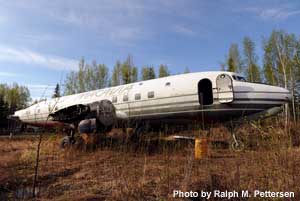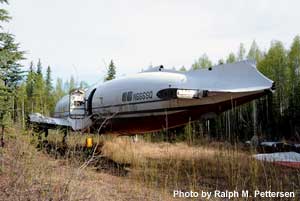During his firebombing career, Jim Buckwalter had a favorite airplane and that airplane was former American Airlines DC-6 N90739/Tanker 68. Jim recounts some of his experiences with T-68 in Arizona during the 1993 and 1994 fire seasons.
 |
 |
 |
 |
 |
 "Here we are pulling up to the load pit at Cutter Aviation at Phoenix, Arizona. Cutter was more of a biz jet FBO and I wondered what they thought of those big old tankers. The tankers would drip oil on their ramp, then taxi through it and leave tire prints of oil on the ramp. They would even roll out a red carpet for us! Every time I got out of the airplane, I would do a walk-around particularly around the engines for an inspection, walking through the oil, then tracking it down the red carpet. They never said anything. The girls were beautiful in their neat uniforms, always smiling and happy. Anyway, that is me at the door where itís about 110 degrees in the shade. Iím about ready to pump 1,500 gal of avgas into the tanks. One of the girls took this photo. Those girls would also bring out some nice box lunches for us. Nice place, but Phoenix Airport was way too busy to run tankers out of there."
"Here we are pulling up to the load pit at Cutter Aviation at Phoenix, Arizona. Cutter was more of a biz jet FBO and I wondered what they thought of those big old tankers. The tankers would drip oil on their ramp, then taxi through it and leave tire prints of oil on the ramp. They would even roll out a red carpet for us! Every time I got out of the airplane, I would do a walk-around particularly around the engines for an inspection, walking through the oil, then tracking it down the red carpet. They never said anything. The girls were beautiful in their neat uniforms, always smiling and happy. Anyway, that is me at the door where itís about 110 degrees in the shade. Iím about ready to pump 1,500 gal of avgas into the tanks. One of the girls took this photo. Those girls would also bring out some nice box lunches for us. Nice place, but Phoenix Airport was way too busy to run tankers out of there."
 "Here is a nice shot of T-68 dropping on a fire west of Phoenix. Del Hunt was captain on T-68 from the time Hank Moore bought it till the USFS cancelled all the piston tanker contracts in May 2004. Del was by far the best mud slinger I ever flew with. He could stand that DC-6 up on a wing and slid that big airplane down in a canyon and drop right on target. It would scare the crap out of me. I watched him perfectly box a small lighting strike up next to a 900í cliff. He would fly right next to the cliff and bank away in a steep turn slipping to lose altitude and drop two doors. Come around and get the other side of the fire with two more doors, then easily connect the two lines into a perfect square with the fire in the box with one load. Unbelievable performance! Heís still flying, only now in the DC-9. I watched a YouTube of a DC-9 do an incredible drop down a mountain side and thought that has Del Hunt all over it. I got a hold of him later, and yes, it was him doing that drop. Del would take the first landing each day, then after the drop gave me the airplane for the rest of the day. I would get 7-8 landings on some days. I got very handy with the DC-6 that summer."
"Here is a nice shot of T-68 dropping on a fire west of Phoenix. Del Hunt was captain on T-68 from the time Hank Moore bought it till the USFS cancelled all the piston tanker contracts in May 2004. Del was by far the best mud slinger I ever flew with. He could stand that DC-6 up on a wing and slid that big airplane down in a canyon and drop right on target. It would scare the crap out of me. I watched him perfectly box a small lighting strike up next to a 900í cliff. He would fly right next to the cliff and bank away in a steep turn slipping to lose altitude and drop two doors. Come around and get the other side of the fire with two more doors, then easily connect the two lines into a perfect square with the fire in the box with one load. Unbelievable performance! Heís still flying, only now in the DC-9. I watched a YouTube of a DC-9 do an incredible drop down a mountain side and thought that has Del Hunt all over it. I got a hold of him later, and yes, it was him doing that drop. Del would take the first landing each day, then after the drop gave me the airplane for the rest of the day. I would get 7-8 landings on some days. I got very handy with the DC-6 that summer."
 |
 |
 |
(Editor's note: I've added two photos of N666SQ taken in May 2019. For its current status, check out this May 26, 2022 news item.)
Jim Buckwalter
June 2022
Photo Credits: Jim Buckwalter, Tom Story. Ralph M. Pettersen
| Page Top | Home |